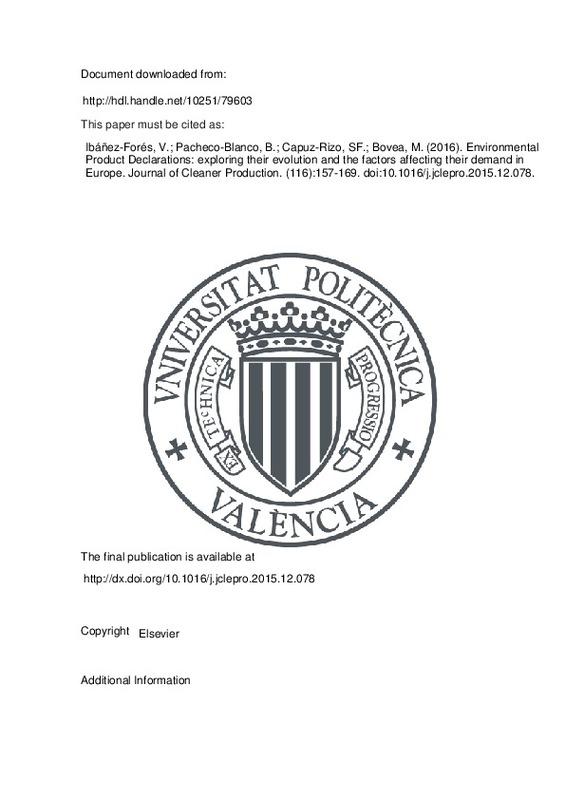JavaScript is disabled for your browser. Some features of this site may not work without it.
Buscar en RiuNet
Listar
Mi cuenta
Estadísticas
Ayuda RiuNet
Admin. UPV
Environmental Product Declarations: exploring their evolution and the factors affecting their demand in Europe
Mostrar el registro sencillo del ítem
Ficheros en el ítem
| dc.contributor.author | Ibáñez-Forés, Valeria
|
es_ES |
| dc.contributor.author | Pacheco-Blanco, Bélgica
|
es_ES |
| dc.contributor.author | Capuz-Rizo, Salvador F.
|
es_ES |
| dc.contributor.author | Bovea, M.D.
|
es_ES |
| dc.date.accessioned | 2017-04-10T09:56:47Z | |
| dc.date.available | 2017-04-10T09:56:47Z | |
| dc.date.issued | 2016-03-10 | |
| dc.identifier.issn | 0959-6526 | |
| dc.identifier.uri | http://hdl.handle.net/10251/79603 | |
| dc.description.abstract | This paper presents the findings of an exploratory study conducted with the aim of analysing the evolution of the use of Environmental Declarations as environmental communication tool in Europe. Previous research has been done in this field focused on analysing differences among Environmental Declaration Programmes, comparison of Product Category Rules and Environmental Declarations for specific product categories, etc. However, the knowledge of the factors affecting their demand from a company perspective is a key aspect for the Environmental Declaration Programmes managers, since it would allow them to orientate future strategies for increasing their implementation. After analysing the evolution of Product Category Rules and Environmental Product Declarations developed in the International EPD® Programme, a survey was designed and distributed to companies that currently had Environmental Product Declarations in that programme. The collected information was related to: factors that led the company to choose the International EPD® Programme as an environmental communication tool, communication channels through which companies came to know about the programme, the target public of the Environmental Product Declarations, whether or not companies intend to renew the current Environmental Product Declarations and the reasons for not doing so if that is the case, etc. Communicating objective information and improvement of the corporate identity of the company have been identified as the main factors for adopting International EPD® Programme as environmental communication tool. On the contrary, the main weakness identified is the lack of knowledge about EPD programmes in general, by consumers. | es_ES |
| dc.language | Inglés | es_ES |
| dc.publisher | Elsevier | es_ES |
| dc.relation.ispartof | Journal of Cleaner Production | es_ES |
| dc.rights | Reserva de todos los derechos | es_ES |
| dc.subject | Environmental communication | es_ES |
| dc.subject | Environmental labelling | es_ES |
| dc.subject | Environmental Product Declaration | es_ES |
| dc.subject | Product Category Rules | es_ES |
| dc.subject.classification | PROYECTOS DE INGENIERIA | es_ES |
| dc.title | Environmental Product Declarations: exploring their evolution and the factors affecting their demand in Europe | es_ES |
| dc.type | Artículo | es_ES |
| dc.identifier.doi | 10.1016/j.jclepro.2015.12.078 | |
| dc.rights.accessRights | Abierto | es_ES |
| dc.contributor.affiliation | Universitat Politècnica de València. Escuela Técnica Superior de Ingenieros Industriales - Escola Tècnica Superior d'Enginyers Industrials | es_ES |
| dc.contributor.affiliation | Universitat Politècnica de València. Escuela Técnica Superior de Ingeniería del Diseño - Escola Tècnica Superior d'Enginyeria del Disseny | es_ES |
| dc.description.bibliographicCitation | Ibáñez-Forés, V.; Pacheco-Blanco, B.; Capuz-Rizo, SF.; Bovea, M. (2016). Environmental Product Declarations: exploring their evolution and the factors affecting their demand in Europe. Journal of Cleaner Production. (116):157-169. doi:10.1016/j.jclepro.2015.12.078 | es_ES |
| dc.description.accrualMethod | S | es_ES |
| dc.relation.publisherversion | http://dx.doi.org/10.1016/j.jclepro.2015.12.078 | es_ES |
| dc.description.upvformatpinicio | 157 | es_ES |
| dc.description.upvformatpfin | 169 | es_ES |
| dc.type.version | info:eu-repo/semantics/publishedVersion | es_ES |
| dc.description.issue | 116 | es_ES |
| dc.relation.senia | 303261 | es_ES |







![[Cerrado]](/themes/UPV/images/candado.png)

